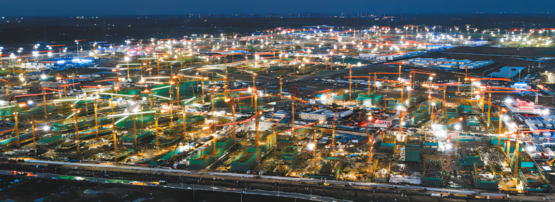
Xiong’an New Area (Xiong’an) is a new Chinese city established in 2017 as a ‘pilot city’, 100kms west of Beijing. The goal for Xiong’an is to create a model for future digital cities. A large part of that model is building in IPv6-only, from the ground up.
IPv6-only
To meet the goal, the local government is prioritizing IPv6, encompassing top-level planning and design for the deployment of 198,000 sensors per square kilometre, resulting in a density of over 1M Internet of Things (IoT) terminals per square kilometre.

To address the risk of network silos, Xiong’an has deployed a city-level IPv4 – IPv6 transition system, facilitating access between IPv6 and IPv4 resources. This system simplifies content delivery, avoiding the complexities associated with dual-stack mode service delivery to all endpoints.
With this transition system (Figure 2), the optical and 5G networks are IPv6-only, employing SRv6 technology for network slicing and serving various virtual private networks (VPN) without the need for overlay networks. The city’s optical network mainly carries devices for urban management, such as cameras, traffic lights, radars and so on. The optical network will deploy future network operating systems, define network functions in software and meet the deterministic requirements of various services in terms of delay, packet loss, and jitter.
Metro networks are dual-stack in public broadband but a challenge remains in enabling home gateways to fully support IPv6, which is being addressed by subsidizing terminals and on-site services.

The IPv4 to IPv6 transition system publishes content to distinct IPv4 and IPv6 network planes, so it’s a single-stack deployment of content within Xiong’an, with a dual-stack delivery to the outside world. This simplifies system complexity at scale by reducing protocol compatibility issues.
Computing centre
Xiong’an has built a ‘city computing centre’ to provide data centre (DC), cloud computing, edge computing, supercomputing, and other service capabilities for enterprises and institutions. Only the Internet egress and the network ‘area’ carrying existing services use dual-stack; all other components inside Xiong’an and the DC are IPv6-only.
The transition system is deployed in the dual-stack area of the city computing centre. It provides IPv6 cloud upgrade services via IPv6 as a Service (6aaS) to existing IPv4 systems and provides backward compatibility services to new IPv6 systems.
The city computing centre has a Power Usage Effectiveness (PUE) of ≤1.1. According to the Uptime Institute, the average data centre’s PUE is 1.58. So this investment is significantly more power efficient, helping to meet green Internet expectations in the future.
Security
Deploying over a million IoT terminals per square kilometre with globally routable IPv6 addresses has brought new challenges to network security in the city. To address security challenges posed by a high density of IoT terminals, the security system uses IPsec to ensure channel security and prevent data from being intercepted during transmission, and blockchain technology to encrypt key data blocks transmitted to prevent data tampering.
City-level IP address management
Xiong’an received a /28 IPv6 allocation (equivalent to over 1 million routable /48 end site subnetworks, and over 256 million /56 consumer or device subnetworks) from APNIC to provide IPv6 address block application services for the government, all enterprises, and all residents.
Users have their own IPv6 address assets to decouple IPv6 address resources and network access and avoid the use of private network addresses and NAT devices in various VPNs, to improve network expansion capabilities. Arguably, the /28 may not be enough depending on the functional outcome.
DHCPv6 provides centralized IPv6 address dynamic allocation services for IoT terminals, reducing the workload of manual configuration. DHCPv6 has been chosen in preference to Stateless Autoconfiguration (SLAAC).
The future for Xiong’an
All this IPv6 aims to power a ‘smart city infrastructure’, which includes a video collection and analysis system, cooperative vehicle infrastructure (including IPv6 digital roads), smart meter reading for utilities, and more. Information from citywide IoT terminals will permit significant improvements in service quality and energy efficiency through outcomes such as transport planning, route improvements and fine-grained energy consumption controls.
Most importantly, Xiong’an’s role as an IPv6-only city will be a functioning prototype that provides real-world lived experience lessons on mass deployment mechanisms, infrastructure and the IPv4 to IPv6 transition systems at scale, as well as IPv6 convergence applications.
Xiong’an is exploring a new path to IPv6 supported by national requirements and internal demand alongside creating the right development conditions and technical support.
Xiong’an International Next-Generation Network Technology (IPv6) Application Competition
The Administrative Committee of Hebei Xiong’an New Area, China Xiong’an Group, and Xiong’an Intelligent City Innovation Federation have launched a global innovation competition focused on IPv6. This competition aims to assess advancements in software technology, hardware products, and creative IPv6 applications. Participation is welcome from both domestic and international enterprises, research institutes, universities, and individuals.
Entrants should register and submit relevant materials via the competition website before 31 March 2024.
Guoliang Yang is the Deputy Director of The New Generation Lab of Xiong’an New Area.
The views expressed by the authors of this blog are their own and do not necessarily reflect the views of APNIC. Please note a Code of Conduct applies to this blog.

This huge project is a very large scale platform to assess the benefit IPv6 bring to cities .As 60 % of population will live in Cities by 2030 and some Cities already reached 90%. connecting people and divices becomes a criitical isuue and challenge to support the socioeconomic development in these cities. So far, City has been adressed from Brodband dimesion through the concept of “GigaCiy” and from Metaverse dimension through “CityVerse”, but IPv6 dimesion that constitutes a fondation to these 2 “City” concepts” needs to be put in place as an additional dimension. we could name “”6City” and this Xiong’an IPv6 project could be seen as an example or an instantiaton of this concept and it fills this gap.. Thanks to this Xiong’s project initiators for making this happen and filling this gao
This